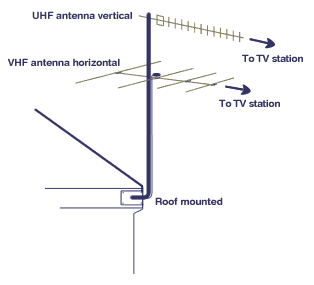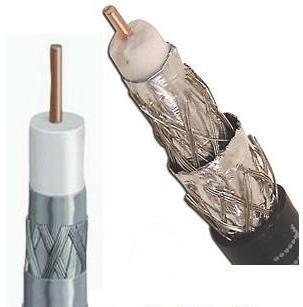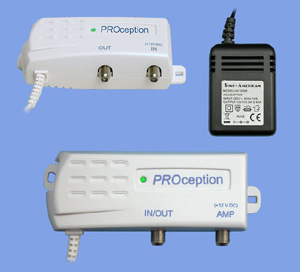

Choosing the correct antenna for the reception needs of a particular area can be a difficult, and sometimes confusing, undertaking. Once again, it is best achieved with the assistance of a professional antenna installer who will know the specific antenna requirements of the local area or region.
The major factors involved with antenna selection and installation are:
What channels will be watched?
What signal strength is available in a given area?
What, if any, reception problems exist in the area?
What polarisation is required?
Are there any local government restrictions on antenna placements?
Will a masthead amplifier be necessary?
Will separate VHF and UHF antennas be necessary for the best antenna system?
Installing A Television Antenna
When installing any type of outdoor antenna, certain basic elements must be taken into account. The installation must be solid and secure. If guy wires are to be used, sufficient area for their installation and solid anchor points are essential. If mounting brackets are used, the fascia, wall or roof must be physically able to support the combined weight of the bracket and antenna and be able to secure the fixture as a whole. Having assessed these basic considerations, choose a suitable location for the antenna installation on your property.
The location should give as clear a ‘line of sight’ to the transmitter, because possible and local obstructions such as trees and rooftops should be avoided where practical.

Ensure that the antenna supporting mast or bracket allows sufficient clearance to enable multiple antenna installation, if required. Make sure also that it enables the antenna installation to operate without being affected by the roof, supporting guy wires or other material that may influence the performance of the antenna system. The mast or bracket should be ‘grounded’ with an earth rod and heavy gauge earthing cable.
Once the antenna bracket or mast is securely installed, mount the antenna(s) on to the bracket or mast, normally with the UHF antenna above the VHF antenna. Coaxial cable should be connected to the antenna(s) and then to the television receiver via a diplexer, if necessary.

The cable weight should be supported by strapping the cable firmly to the mast or bracket. It is important to ensure that the coaxial cable is strapped tightly enough to prevent movement, but not so tight as to crush the cable. It is essential that the coaxial cable is not stretched or damaged during installation, because any damage to the cable can affect its operating parameters and possibly the quality of the signal received.
While do-it-yourself antenna installations can be easily and satisfactorily undertaken in strong signal strength areas, the use of a professional antenna installer can save much time and effort. If the installation is to be carried out in an area of problem reception, then the assistance of a professional antenna installer is highly recommended.
Choosing The Right Coaxial Cable
Choosing the right cable is important. To minimise the pick up of electrical and other interference it is recommended to purchase RG6 Quad Shield cable with F Connectors attached on the cable. This cable will minimise the effects of picking up unwanted interference and electrical impulse noises.


Antennas and masthead and distribution amplifiers

Masthead and distribution amplifiers are used in television systems to increase the level of signal received at a television set. Television masthead and distribution amplifiers can produce radio signal interference. Incorrect use or faulty amplifiers can affect broadcast television reception, CDMA and GSM mobile phone systems and two-way radio communications systems.
© Digital Television For Dummies 2008